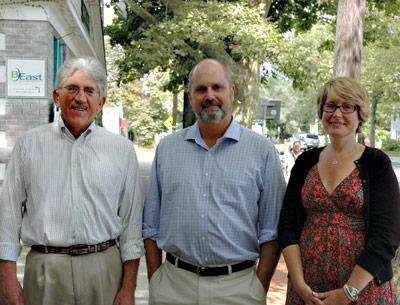Blueprint For a New Town Board
Blueprint For a New Town Board

The Democratic candidates for East Hampton Town supervisor and town board tackled issues as specific as the staffing of the town supervisor’s office and as broad as coastal policy, “managing growth,” and investments in the town’s infrastructure in their platform released last week and in a discussion of it on Friday.
The document, said Job Potter, who is running for town board along with Kathee Burke-Gonzalez, “is a blueprint . . . for a new town board.”
“This is an attempt to begin to address many of the issues that will be important in the campaign and will be important in January,” said Larry Cantwell, the supervisor candidate, who is running unopposed pending results of a Republican write-in primary.
The three have “a pretty good understanding of how government works and how to make it work better, not for us, but for the people,” said Mr. Cantwell, the East Hampton Village administrator for over three decades and an East Hampton Town councilman before that. Mr. Potter served two four-year terms on the town board and was on the town planning board before that. Ms. Burke-Gonzalez just finished nine years on the Springs School Board, the last two as president.
While there are matters of greater importance that a new town board will have to tackle — many of them outlined in the platform — “the biggest thing people mention on the street so far is the animosity on the town board and how the public is being treated,” Mr. Potter said Friday during a meeting with reporters at D’Canela restaurant in Amagansett.
“It’s very hard to get things done when you’re operating in an adversarial environment,” Mr. Cantwell said. The town board has been sharply split of late, with the outgoing Republican Supervisor Bill Wilkinson and his closest and often only ally on the board, Councilwoman Theresa Quigley, on one side of the divide and Dominick Stanzione, also a Republican, staking out the middle ground or siding with the Democrats Sylvia Overby and Peter Van Scoyoc.
The Democratic candidates paint a rosier picture of a board that would “work toward consensus solutions . . . to benefit the community as a whole,” give the public more opportunities to participate in decision making, and reopen lines of communication that have frayed to realize savings, pointing specifically to the possibility of consolidating the town and village emergency communications departments, which they said would save money for both municipalities, not to mention the fire districts that use the emergency 911 system. “This may achieve a savings of $700,000,” according to their platform.
As far as long-term capital spending is concerned, the Democrats said there are significant needs resulting from lack of maintenance as the town climbed out from under the crushing deficit left by the McGintee administration in 2010. The town needs a five-year capital plan that addresses priority needs without increasing the town’s already high annual debt service payments, the Democrats said, something they believe is possible in part because the town’s overall debt, not including preservation fund debt, is expected to “decline from about $96 million to about $25 million” over the next 10 years.
“We believe the town’s financial stabilization has left some gaps in important areas, with services and important functions of the town negatively impacted,” they say in their platform. The town’s beaches are a prime example, Mr. Cantwell said. “The beaches are probably one of our most important assets,” for year-round residents, second-home owners, summer visitors, and tourists. “The garbage cans are deplorable,” Mr. Cantwell said. “The public restrooms are neglected.”
On the subject of the airport, the Democrats do not take a position on the controversial subject of whether the town should continue to accept Federal Aviation Administration funding for airport projects, but they do call for “legally enforceable restrictions” to limit aircraft noise.
“One of the things we’ve proposed is that the town do a financial analysis and business plan for the airport,” Mr. Cantwell said, so that it can get a “fair projection of fees and revenue sources,” as well as an understanding of operational costs and the cost of capital improvements over the next several years.
In terms of aircraft noise, Mr. Potter said the town should “vigorously pursue what kind of limitations might be possible.” The platform calls for doing this by first establishing that East Hampton is a “quiet community and that airport access restrictions which we will propose can significantly reduce airport noise.”
“I’d like to see the town on a parallel track with respect to funding and regulation,” Mr. Cantwell said.
Democrats also said they would make it a priority to deal with more widespread noise and quality-of-life complaints. “Enforcing our quality-of-life laws is one of the major issues in the community,” Mr. Cantwell said.
To deal with that, the Democrats propose hiring an additional code enforcement officer to “specialize in residential zoning enforcement,” but it will take more than that, they said. The platform offers a number of specific proposals including increasing the maximum fines for zoning violations, defining the number of cars and size of commercial vehicles allowed on residential property, and amending the town code to require that “the number of allowable bedrooms and bathrooms be listed on the certificate of occupancy.”
They also propose organizational changes to better deal with enforcement and compliance of quality-of-life laws. They want to reorganize the Building Department and appoint a chief building inspector who holds that Civil Service title, “engage a strong, fully staffed legal department with professional attorneys providing sound independent legal advice,” and create an “an interagency working group” drawn from the Police, Code Enforcement, Fire, and Building Departments as well the town attorney’s office to focus on “residential zoning violations and health, safety, and welfare issues.”
“Things are starting to get out of control,” Mr. Cantwell said.
While the town works to manage quality of life on an everyday basis, it also needs to consider the bigger picture, and should look to its comprehensive plan and local waterfront revitalization plan “to guide growth while protecting and preserving what is special about East Hampton,” the platform says.
“It’s striking to me in recent years that there’s been such a breakdown in terms of relations with the Planning Department and the town board,” Mr. Potter said. “The comprehensive plan has been essentially ignored whenever laws are written,” he said, when it should actually be “a starting point and a reference.”
Mr. Cantwell decried a trend toward considering spot-zoning proposals for certain parcels, among them the Cyril’s property on Napeague. “You have a comprehensive plan; you looked at the big picture, and you ended up adopting the plan,” he said.
Another big-picture issue the Democrats have raised again and again is the need to better plan for climate change, sea-level rise, and post-storm recovery.
“One critical element of the Local Waterfront Revitalization Plan left unfinished is a hazard mitigation and recovery plan,” the platform says, the purpose of which “is to identify hazards and areas of vulnerability along our shoreline so we can take positive actions and build resiliency in advance to limit damage from serious storms and hurricanes in the future.”
“We have 100 miles of coastline in East Hampton Town,” Mr. Cantwell said. “The biggest physical threat to our town is the potential future threat from sea-level rise. We’ve got to get ready. . . . We can model the level of damage that will occur from different levels of storms.”
As for the federal money slated to come to East Hampton to rebuild beaches and dunes, “Our clear preference is that this be a soft replenishment project,” Mr. Cantwell said. He also hopes the town is given options so that it can choose a “beach and dune replenishment project that is a meaningful one.”
“The town needs to have its own coastal expert and should have already had one on board nine months ago to help develop what some of the best options are,” he said.
At a meeting this spring, representatives from the Federal Emergency Management Agency “talked about us being a shelter-in-place community,” said Ms. Burke-Gonzalez. “We’re not prepared.”
“We need to do a better job of communicating in general, but especially after a natural disaster,” Mr. Cantwell said. “People get afraid when they don’t know what’s going on and they get reassured when they know what’s going on. That’s one reason we need to have an administrative head in the supervisor’s office,” as well as a secretary. That support staff is necessary in order for the supervisor to be effective and for handling constituent concerns, he said.
The Democrats’ platform can be found in its entirety at ehdems.com.
In the coming weeks, Mr. Cantwell, Ms. Burke-Gonzalez, and Mr. Potter will continue a series of listen-ins with constituents in the town’s various hamlets and villages. They have already met with Springs, Montauk, and Amagansett residents and plan additional listen-ins in Sag Harbor, East Hampton, and Wainscott.





